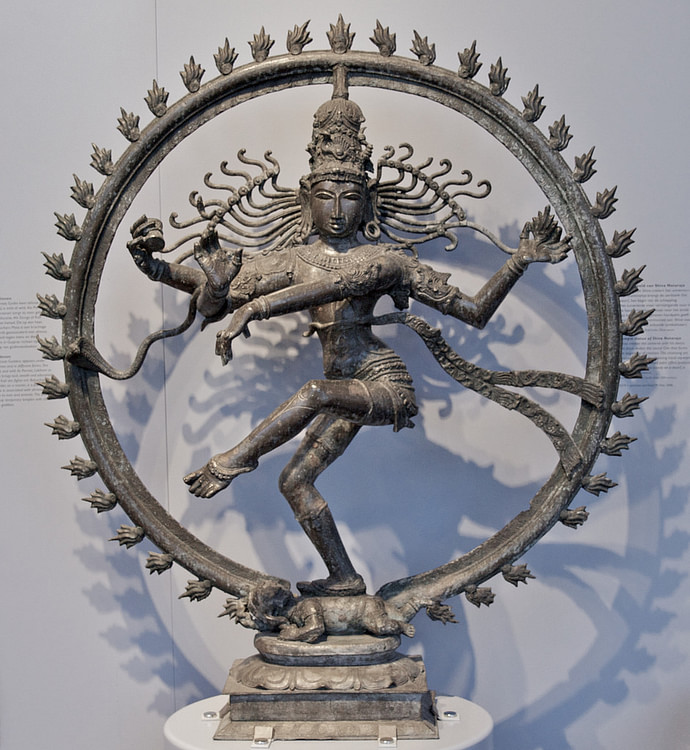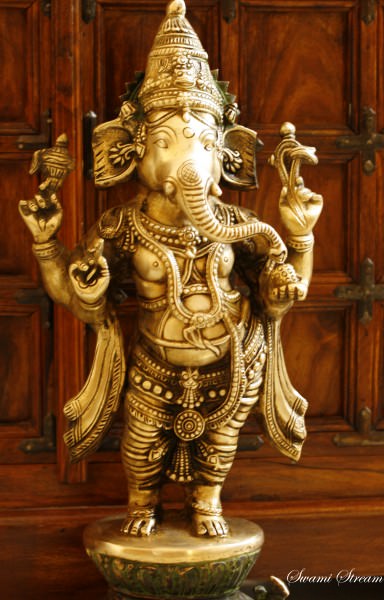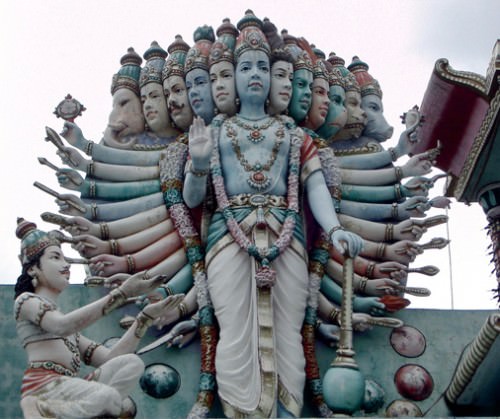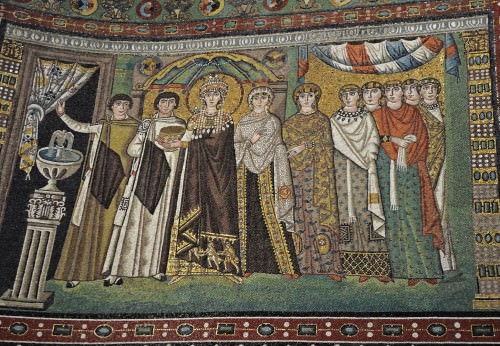Hinduism › Theodora: A True Heroine? ›› Ancient origins
Articles and Definitions › Contents
- Hinduism › Ancient History
- Theodora: A True Heroine? › Who Was
Ancient civilizations › Historical and archaeological sites
Hinduism › Ancient History
Definition and Origins

Unlike other religious traditions, Hinduism does not originate in a single founder, a single book or a single point in time. It contains many different beliefs, philosophies and viewpoints, not always consistent with each other. These apparent contradictions strike only those who are not familiar with this tradition: the Hindu insight claims that the Oneness expresses itself in many different forms.
Hinduism is often labelled as a religion, but it is actually more than that: it is a vast and complex socio-religious body which, in a way, reflects the complexity of Indian society. A rich geography, many languages and dialects, lots of different creeds, racial diversity, all these elements have shaped Hinduism and made it so heterogenic. The lack of unifying overall religious authority and the total absence of a book claiming supreme truth and dogmas have contributed to the diversity of Hinduism as well. It is fair to mention that even the texts we find in Hinduism that claim some sort of divine inspiration do not declare their view to be better than any other and they all exist together in a tolerant fashion. The many manifestations of Hinduism go from highly intellectual philosophies concerning numerous and puzzling metaphysical concerns, many rituals, mental and physical exercises such as Yoga to simple, almost childlike, tales and legends.
THE FOUNDATIONS OF HINDUISM CAN BE FOUND IN THE TEACHINGS OF ANONYMOUS ANCIENT SAGES OR RISHIS.
This tradition has come down to us from prehistoric times. The foundations of Hinduism can be found in the teachings of anonymous ancient sages or rishis, which were originally transmitted orally. We know very little about Hinduim beyond what can be learned from the Vedas, a collection of hymns and other ritual texts composed in different periods. These texts contain a lot of material including the teachings of the early sages. The oldest evidence of religious practices in India date back approximately to 5500 BCE. It is a mistake to reduce all early Hinduism to Vedic religion: there were many other non-Vedic religious traditions in early Hinduism which have left no early texts and that can be known to some extent by archaeological evidence.
Just like Zoroastrianism and Judaism (the other two major world religions also coming to us from prehistoric times), Hinduism has received numerous shocks that threatened its foundations and it has resiliently survived all of them. Judaism and Zoroastrianism also survived the many impacts they received, but Judaism failed to absorb Christianity, its all-conquering offspring, which after just a couple of centuries clearly overshadowed it, and there are only around 200,000 Zoroastrian believers left today. The basis of Hinduism has been hit, sometimes even smashed, by many sects, movements and systems of thought: in the worst case scenarios it receded for a while, only to return more powerful than before. Movements challenging the authority of the priestly orthodoxy, irreligious schools such as the Charvaka, atheist traditions like Jainism, the Buddhistagnostic approach, nihilists and skeptics denouncing the cunning behind the sacrificial fees, all of these beliefs weakened Hinduism for some time and were eventually absorbed, recycled and merged into the enormous body of this old Indic faith.
DARSÁN : THE EMPHASIS OF THE VISUAL EXPERIENCE
We read in the Brahmanas, a group of sacred priestly texts attached to the Vedas :
The eye is the truth. If two persons come disputing with each other [...] we should believe him who said 'I have seen it', not him who has said 'I have heard it.'
Hinduism attaches a very special value to the the darsán (a sanskrit word meaning sight), of gurus, leaders, saintly persons and even holy places and holy images. According to the Hindus, darsán is a two-way flow of vision. While the devotee sees the god, so too the god sees the devotee, and the two can make contact through their eyes. When the images of the gods are made, its eyes are the last part to be completed. It is not until the image is consecrated that its eyes are finally opened with either the touch of a paintbrush or using a golden needle. Popular gods like Shiva and Ganesha have a third eye located in their forehead. The god Brahma, the Thousand-Eyes, often has four heads and looks in all directions at once. This emphasis on the vision and the image dominates the Hindu's relation to the gods, appearing to be just the opposite of many other religions.

Ganesha
MANY IS BETTER THAN ONE
Abrahamanic religions are dominated by the notion that One is better than many: One God, One Book, One Son, One Church, One Nation of God. In Hinduism, the more the better: many gods, many books, many sages, many insights.
In this ever-growing community of endless gods and goddesses, the roles of the gods and even their hierarchy are somehow diffuse. Some gods get more attention than others and different accounts suggest different hierarchies. Olympian gods, who had a clear hierarchy, may look greedy and envious compared with the tolerant gods of Hinduism.
Agni, Indra, Shiva, Brahma, Vishnu and Ganesha are just a few examples of very important Hindu gods that were regarded at different times and by different sects as the most important gods. Shiva, Vishnu and Brahma were part of a holy Hindu trinity (trimurti). Shiva is sometimes associated with the destruction process and Vishnu as the creator who takes the remains destroyed by Shiva in order to regenerate what has been destroyed. For the Ganapatya Hindu sect, Ganesha is the most important deity. Ganesha is highly recognizable with his elephant head and human body, representing the soul ( atman ) and the physical ( maya ) respectively. He is also the patron of writers, travellers, students, commerce, and new projects (for which he removes obstacles from one's path) and is rather fond of sweets, to the slight detriment of his figure.

Krishna manifesting his full glory to Arjuna
THE RIDDLE OF CREATION
Trying to answer the big questions of life, Hinduism offers several different accounts for the origin of the universe. Here we also see traces of the complexity of Hinduism: the question has been approached in so many different ways.
One account says the universe came into existence as a result of the sacrifice of a primeval being, Purusha, who existed even before time. The gods appear to have been his children. Purusha is dismembered by the gods. Purusha's mind became the Moon, his eyes the Sun, the Sky came from his head, and the Earth came from his feet.
There is a famous creation quote in the Rig- Veda which suggests a certain skepticism on whether the origin of the universe is a knowable topic.
Then was not non-existent nor existent: there was no realm of air, no sky beyond it.
What covered in, and where? and what gave shelter? Was water there, unfathomed depth of water? [...]
Who verily knows and who can here declare it, whence it was born and whence comes this creation?
The Gods are later than this world's production. Who knows then whence it first came into being?
He, the first origin of this creation, whether he formed it all or did not form it,
Whose eye controls this world in highest heaven, he verily knows it, or perhaps he knows not.(Rig-Veda 10.129.1-7)
It seems quite an extraordinary idea that even the gods, even the Highest Seer in the Highest Sky, could possibly not know it all.
There is another account on how the universe started, which has no equivalent in any other tradition. The universe is actually the dream of a god who after 100 Brahma years, dissolves himself into a dreamless sleep, and the universe dissolves with him. After another 100 Brahma years, he recomposes himself and begins to dream again the great cosmic dream. Meanwhile, there are infinite other universes elsewhere, each of them being dreamt by its own god.
This idea could actually reverse the cause and the effect, since humans may not be the result of the dreams of the gods, but rather the gods may be the result of the dreams of humans.
Theodora: A True Heroine? › Who Was
Ancient Civilizations
Was Theodora I, the wife of Emperor Justinian of Byzantium (reigned 527 - 565 CE), a heroine? The historian Treadgold calls her a protectress of women, as she used her influence to help them gain rights. She is also seen in popular legend as a protector and defender of the poor and weak. Because she was a close collaborator, some even say a co-ruler, with her husband, it is extremely likely that she was able to influence policy and even laws that helped to achieve these ends. Does this make her a heroine? The answer to this question depends on how one defines heroine and who one asks.

Empress Theodora & Her Court
Theodora became a character in popular Greek legend who possessed many of the qualities of a hero. Campbell says that heroes are partly defined as protectors and defenders, attributes that are shown in Theodora's character, and she was also wise and beautiful, qualities often attributed to classical heroes. Theodora effectively changed the course of history both when she dissuaded her husband from taking flight during the Nika riots and when she influenced changes in laws and rights.Because of this, she is sometimes referred to as a heroine, even though Procopius and some other historians focus on the deaths that the dissuasion cost. Theodora also possessed three Christian values which are attributed to a Christian heroine: The value of faith is expressed by Treadgold, as she was pious as well as faithful to her husband; she was also charitable to those who were less fortunate, as she had once been; and she is said to have been penitent which was parallel to Mary Magdalene. These values support the idea that Theodora was a heroine in a religious and Christian sense.
THEODORA WAS SMART AND RUTHLESS, & IN HER EARLY LIFE A PROSTITUTE & ACTRESS.
There is considerable controversy about the personality of Theodora which plays a significant role in determining whether or not Theodora was a heroine. Procopius, a high official, historian, and contemporary of Theodora, greatly disapproved of Theodora's personality and background - she was smart and ruthless, and in her early life a prostitute and actress - blaming her for political and financial upheaval. Foss describes her as “less than saintly”. Procopius's notorious account of Theodora in his 'Secret History' shows extreme dislike for her character; he, and Byzantine society in general, evaluated her former occupations as very near the bottom of the “hierarchy of the arts”. Procopius writes that Theodora was secretive and unfaithful, yet this charcterization can be attributed mostly to his own personal bias against her; historians suggest this characterization is not completely accurate, as does the way Theodora has been made into a prominent figure in Greek legend. Theodora was a very commanding personality with great influence as seen in her persuading Justinian to change laws and her reaction to disloyalty when she was left effectively in control while Justinian suffered from the plague. Theodora was strong willed, opinionated, and believed that women should have rights. This view of women in itself was controversial in what was primarily a patriarchal society. This does not mean that Theodora was not a heroine, of course. If we were able to ask Procopius that question, chances are that he would have said no. The women and the poor that she stood up for likely would have said yes.
LICENSE:
Article based on information obtained from these sources:with permission from the Website Ancient History Encyclopedia
Content is available under License Creative Commons: Attribution-NonCommercial-ShareAlike 3.0 Unported. CC-BY-NC-SA License